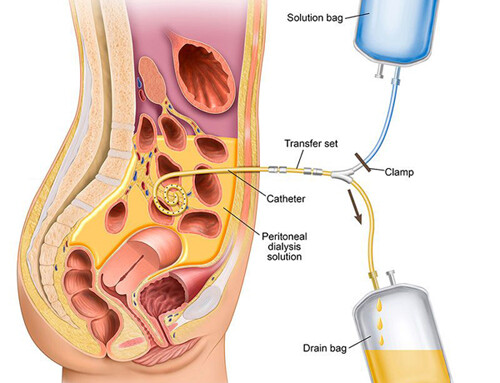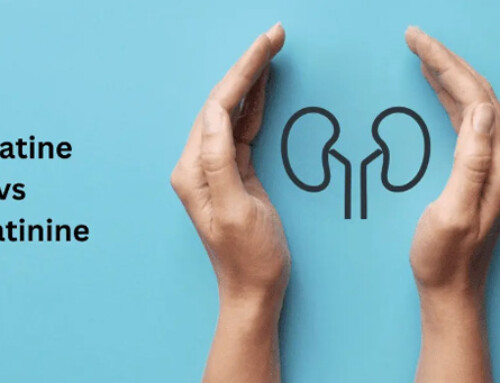Table of Contents
Anemia is an almost universal finding in patients with End Stage Renal Disease requiring dialysis. The following factors contribute:
- Erythropoietin deficiency: The kidneys normally secrete erythropoietin which stimulates the bone marrow to produce red blood cells. When the kidneys fail, erythropoietin deficiency occurs with resultant anemia.
- Iron deficiency: Patients on hemodialysis have ongoing blood loss for labs and through the hemodialysis circuit. This slow chronic blood loss can result in iron deficiency. In addition there is decreased iron availability referred to as relative iron deficiency. The inflammatory state of kidney failure results in impaired gastrointestinal iron absorption and availability of systemic iron stores. This is mediated through hepcidin.
This article will address:
- Treatment of anemia in ESRD
- Causes of erythropoietin (epo) resistance
- Evaluation of ESRD patients who do not require an erythropoietic stimulating agent (as this is unusual).
Treatment of Anemia in ESRD
The mainstay of anemia treatment in dialysis patients includes:
- Erythropoietic stimulating agents
- Iron
Erythropoietic stimulating agents:
- Epoetin alpha (Epogen): This has been the traditional agent used in ESRD. The initial recommended dose is 50-100 units/kg three times a week.
- Methoxy polyethylene glycol – epoetin beta (Mircera): This is a continuous erythropoietin receptor activator (CERA). Large dialysis providers (Davita and Fresinius) have transitioned to this formulation. Initial dose is 0.6 mcg/kg every 2 weeks.
These medications can be given either intravenously or subcutaneously. In hemodialysis patients they are most often given intravenously with dialysis for reasons or convenience and avoiding patient discomfort.
Read more about the different erythropoietic stimulating agents in this editorial:
Anemia Treatment in Patients with Chronic Kidney Disease | NEJM
Things to know:
- The dose adjustment/titration administration of these medications is often driven by protocols established by the dialysis provider. Reasons for this are that this class of medication is a major expense for dialysis providers and large changes in dose or abrupt holding can result in wide fluctuations and a “yo – yo” phenomenon of hemoglobin levels which may not be good for the patient.
- Target Hemoglobin (Hg) is typically 10-11.5 in dialysis patients. Further correction of Hg to normal is not associated with benefit and may be associated with harm including:
- Thrombosis (access thrombosis and CVA)
- HTN
- This class of medications may also be associated with increased risk of cancer growth in patients with malignancy. In these patients a lower Hg target may be appropriate.
- The protocols do not work for all patients. Be aware of patients that need to be managed “off protocol”.
Iron
Iron is crucial for the treatment of anemia in dialysis patients. This may be the most common cause or epo resistance (see below).
- Iron is necessary for an erythropoietic stimulating agent to work
- There are ongoing chronic iron losses, particularly via lab draws and RBC loss in the hemodialysis circuit. Hemodialysis patients lose 1-2 grams of iron per year
- ESRD is a chronic inflammatory state with impaired iron absorption and release, radiated by hepcidin.
For these reasons in dialysis patients:
- Iron is typically given intravenously (as opposed to orally)
- Low dose maintenance iron is often given (to offset the chronic blood/iron losses)
- The “cutoff” for iron deficiency is different. (to account for the acute phase reactant component of ferritin and the decreased bioavailability of systemic iron stores – relative)
- Intravenous iron would not be held unless ferritin is > 800 – 1200 or iron saturation is > 50%
- An intravenous iron load is typically given if the ferritin is < 100 – 200, or the iron saturation is < 30% with a ferritin of < 800-1200.
What about hemochromatosis? Am I going to cause secondary hemochromatosis and liver damage?
If you look at the data of patients with hemochromatosis who develop systemic complications you will find:
- The iron saturation is invariably > 50%
- The ferritin is typically > 2000
Iron Dosing
Intravenous:
- Iron Dextran (Infed)
- This was the initial intravenous iron. It had the benefit of being able to be given in large doses (ie 1 gram) in a single setting. However, there was a risk of anaphylaxis. It is rarely (if ever) used currently.
The most common current intravenous iron formulations used in dialysis are:
- Iron sucrose (Venofer)
- This has a lower risk of anaphylaxis. However, it can only be given in lower doses in a single setting because of free iron related adverse effects.
- Typical doses:
- Maintenance: 50 mg weekly or 100 mg every other week
- Loading Dose: 1 gram (100 mg each treatment x 10 treatments)
- Ferric gluconate (Ferrlecit)
- Like Iron sucrose, this has a lower risk of anaphylaxis andcan only be given in lower doses in a single setting because of free iron related adverse effects.
- Typical doses:
- Maintenance: 62.5 mg weekly or 125 mg every other week
- Loading Dose: 1 gram (125 mg each treatment x 8 treatments)
Complications of the newer IV iron formulations (iron sucrose and ferric iron gluconate) include:
- Hypersensitivity reactions (including anaphylaxis) – rare
- Hypotension
- GI (nausea/vomiting/diarrhea)
- Headache
- Cramping
In addition intravenous iron should not be given in the context of an active infection as it may act as a substrate for bacteria.
Oral:
- Ferric citrate (Auryxia)
- This is a phosphorus binder that can be used in ESRD. It also has been shown to raise iron saturation, ferritin, and hemoglobin.
Causes of Epo Resistance
Some patients remain with Hg levels below target despite high doses of an erythropoietic stimulating agent.
Causes to consider include:
- Iron deficiency/ Relative iron deficiency
- Infection
- Hematologic disorders (ie myelodysplastic syndrome, sickle cell disease)
- Pure red cell aplasia
- Nutritional (B12/Folate) deficiency
- Hyperparathyroidism
- Bleeding
- Hemolysis
Evaluation of Dialysis Patients who don’t require EPO
What about a patient with high or normal hemoglobin without an erythropoietic stimulating agent? In these cases you need to think about situations why the kidneys would still make erythropoietin even though they have failed.
Things to consider are:
- Autosomal Dominant Polycystic Kidney Disease (ADPKD)
- Renal Cell Carcinoma (RCC)
- Myeloproliferative Disorder
For this reason patients on dialysis who do not require an ESA are often screened with imaging, typically a renal ultrasound. This is talked about more than actually seen. Personally, I have not seen a case of RCC diagnosed this way.
Transfusions
Although transfusions may be necessary in dialysis patients reasons to avoid them include:
- Alloimmunization: Transfusions are a common cause of HLA antibodies that may increase the risk of sensitivity and a positive cross match against potential kidney transplants.
- Secondary iron overload. Transfusions contain iron. Frequent transfusions are a cause of secondary iron overload.
Even though transfusions should be avoided I am going to argue against using a transfusion trigger of 7, I believe it should be more liberal, (maybe 7.5).
What can happen is the following:
- A patient’s pre dialysis Hg is below 7. They are sent to the ER post dialysis. After dialysis the patient is hemo-concentrated because of ultrafiltration and the Hg is above 7. They are not transfused and sent home only for the cycle to repeat itself the following week.
- If the patient’s Hg drops to below 7 during the interdialytic interval they may require an additional dialysis session to accommodate the volume of a transfusion or because intravenous access for transfusion is not obtainable.
Summary
Anemia is almost a universal finding in patients with dialysis dependent ESRD. Mainstays of treatment are erythropoietic stimulating agents and intravenous iron. In patients who are epo resistant or do not require an ESA other diagnoses should be pursued.



